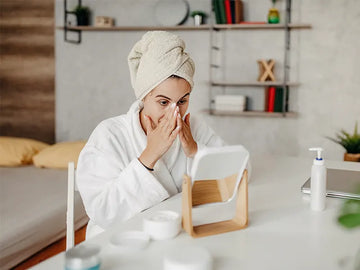
Transform your morning skincare ritual with the innovative concept of skin cycling. This strategic approach to product application maximizes benefits while minimizing irritation. Dive into our comprehensive morning routine that aligns with skin cycling principles, ensuring your skin receives balanced care to start the day with radiance and resilience.
What is the Skin Cycling routine for morning?
The skin cycling morning routine typically involves a gentle cleanse followed by the application of a moisturizer and, crucially, sunscreen to protect the skin throughout the day. Unlike the night routine, which alternates between exfoliation, retinoids, and recovery, the morning routine remains consistent to maintain hydration and shield the skin from environmental stressors. It's essential to keep the morning regimen simple and focused on protection.
Skin Cycling Morning Routine
A skin cycling morning routine can help you to get the most out of your skin care products. Here is a step-by-step guide to a basic skin cycling morning routine:
Step 1: Cleanse
Cleansing is the first step in your skin cycling routine.
It's important to choose a cleanser that suits your skin type.
For sensitive skin, a gentle, fragrance-free cleanser is recommended.
Always use gentle techniques for morning cleansing to avoid irritating the skin.
Cleansing helps to remove any excess oils and impurities from your skin, preparing it for the next steps of your skincare routine.
Step 2: Toning
Toning serves to balance the pH of your skin and prepare it for the subsequent steps of your skincare routine.
Look for toner ingredients that offer morning revitalization, such as hyaluronic acid for hydration and vitamin C for brightening.
Toning can also help to minimize the appearance of pores and provide an extra layer of protection against environmental factors.
Step 3: Serums and Treatments
In the morning, consider using serums that address specific concerns like hydration and antioxidant protection.
Vitamin C serum is a popular choice for morning use due to its brightening and antioxidant properties.
Dr. Whitney Bowe suggests that using a vitamin C serum can help to neutralize free radicals, stimulate collagen production, and reduce signs of aging.
The main vitamin C source and a serum bottle can be seen in the below image.

Remember, combining serums can lead to maximum effectiveness.
Step 4: Eye Care
Eye cream is an essential part of the morning routine. It helps to hydrate the delicate skin around the eyes and reduce the appearance of fine lines and wrinkles.
Always apply eye products gently to prevent damage.
According to Dr. Whitney Bowe, using an eye cream can also help to reduce puffiness and dark circles under the eyes.
Step 5: Moisturizing
Choosing the right moisturizer for the morning is crucial.
It should be hydrating yet lightweight enough not to leave your skin feeling greasy.
Moisturizing helps to lock in hydration for the day ahead.
Dermatologists emphasize the importance of hydration for skin health, stating that hydrated skin is smooth, supple, and reflects light evenly, giving off a radiant glow.
Step 6: Apply Sunscreen
Sunscreen is a non-negotiable step in the morning routine. It protects your skin from harmful UV rays, which can lead to premature aging and skin cancer.
Remember to apply it generously and evenly across all exposed areas of your skin.
I recommend using a broad-spectrum sunscreen with an SPF of at least 30.
In addition to these steps, it's important to remember that everyone's skin is different, and what works for one person may not work for another.
Always listen to your skin and adjust your routine as needed. If you have sensitive skin, my suggestion is to introduce new products one at a time and avoid fragrances, which can cause skin reactions.
Preparing for Your Morning Routine
Cleansing the Night Before
A clean canvas is essential for morning skincare.
Using a gentle cleanser the night before can help remove makeup, dirt, and excess oils, preparing your skin for the morning routine.
It's important to consider the type of cleanser you use.
For instance, oil-based cleansers are effective at removing makeup and excess sebum, while water-based cleansers can help remove sweat and dirt.
Morning Skin Assessment
Identifying specific skin concerns in the morning is crucial.
Analyzing changes in skin condition from the night before can help you adjust your skincare routine accordingly.
However, Skin cycling can help address these changes.
Skin cycling involves adjusting your skincare routine based on your skin's needs, which can change due to factors like weather, stress, and hormonal fluctuations.
Enhancing Your Morning Routine
Use Gentle Exfoliation (Occasional)
Exfoliation can help remove dead skin cells and reveal a brighter complexion.
However, it should be done sparingly, especially for those with sensitive skin.
Choose mild exfoliants for morning use to avoid skin irritation. According to Dr. Whitney Bowe, it's important to be mindful of your skin's response to exfoliation.
If you experience any burning, wash off the exfoliating serum immediately.
Slight tingling is okay, but it isn't necessary to see real results over time.
Facial Massage and Lymphatic Drainage
Facial massage can help relax your facial muscles and improve blood circulation.
Additionally, lymphatic drainage techniques can help reduce morning puffiness and give your skin a fresh, youthful look.
You can use a jade roller or gua sha tool for this purpose. The below images shows the gua sha and the jade roller tools.

These tools can help stimulate lymphatic drainage and relieve tension in the facial muscles.
Hydration from Within
Hydration and diet play a crucial role in maintaining skin health. Drinking plenty of water and consuming hydrating foods and beverages can help keep your skin plump and radiant.
But, Dermatologists say that water alone isn't enough for optimal skin hydration.
Incorporating hydrating skincare products and consuming a balanced diet rich in fruits and vegetables can significantly improve your skin's hydration levels.
Sensitive Skin Consideration
If you have sensitive skin, it's important to introduce new products one at a time and avoid fragrances, which can cause skin reactions.
Dr. Whitney Bowe recommends starting with a gentle over-the-counter retinol or retinal rather than a prescription-strength retinoid.
She also suggests using a fragrance-free moisturizing cream around the most sensitive areas—such as your eye area, smile lines, chin, or neck—prior to applying your retinoid.
This can help serve as a buffer or barrier, protecting these sensitive areas from the powerful retinoid, especially while your skin is adjusting.
Customizing Your Morning Skin - Cycling Routine for Different Skin Types
Dry Skin
If you have dry skin, use a hydrating cleanser to help replenish moisture. After cleansing, apply a vitamin C cream or serum in pea-sized amounts to your face, neck, and décolletage.
Vitamin C is known for its antioxidant properties and can help brighten your skin.
Follow this with a rich moisturizer to lock in hydration.
Lastly, apply an SPF sunscreen to protect your skin from harmful UV rays. You can also add a hyaluronic acid serum as an extra step for additional hydration.
Limit exfoliation to once a week to avoid stripping your skin of its natural oils.
Oily or Acne-Prone Skin
For oily or acne-prone skin, start with a cleanser containing salicylic acid. This ingredient can help control oil production and prevent acne.
After cleansing, apply a lightweight, oil-free moisturizer to keep your skin hydrated without making it feel greasy.
Then, apply a non-comedogenic sunscreen that won't clog your pores.
If you have acne-prone skin, you might also want to incorporate a benzoyl peroxide spot treatment or a cleanser containing benzoyl peroxide in your morning routine.
Sensitive Skin
Sensitive skin requires extra care. Choose a gentle, fragrance-free cleanser to minimize the risk of irritation.
After cleansing, apply a soothing serum or cream, such as one containing calendula oil and grapefruit oil, which are known to reduce inflammation and support skin barrier repair.
Follow this with a hypoallergenic moisturizer.
Lastly, apply a sunscreen that's suitable for sensitive skin. Always introduce new products one at a time and do a patch test before incorporating a new product into your routine.
Tips for a Successful Skin Cycling Morning Routine
Use gentle products: Always opt for products that are gentle on your skin to avoid irritation.
Start slowly: When introducing new products into your routine, start slowly to give your skin time to adjust.
Listen to your skin: If a product causes irritation or discomfort, stop using it immediately.
Be patient: Skincare takes time. Don't expect immediate results and be patient with your skin.
Stay consistent: Consistency is key in a skincare routine. Stick to your routine and don't skip days.
Protect your skin: Always apply sunscreen to protect your skin from harmful UV rays.
Frequently Asked Questions
1) How many days is skin cycling?
Skin cycling doesn't have a fixed duration. It depends on your skin's needs and the products you're using. However, a typical skin cycling routine involves alternating between different products every few days.
2) How often should you do skin cycling?
Skin cycling is a daily routine. The key is to alternate between different products to address various skin concerns.
3) How long does purging from skin cycling last?
Skin purging typically lasts for about four to six weeks. If your skin is still breaking out after this period, it might be a reaction to a product.
4) Is skin cycling only at night?
No, skin cycling can be done both in the morning and at night. But, the main focus goes for the four night routine. The products you use will depend on the time of day and your skin's needs.
Conclusion
Skin cycling is a dynamic and flexible approach to skincare that can yield impressive results when done correctly.
By following the steps outlined in this article and adapting the routine to your individual needs, you can achieve healthier and more radiant skin.
Remember, consistency is key in skincare. Stick to your routine, be patient, and you'll start to see improvements in your skin's texture and appearance.
Related Posts:




